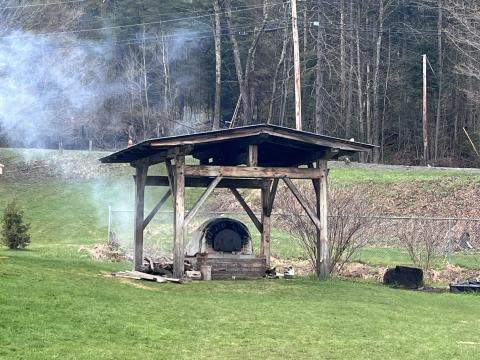August 27, 2024

Dominick Hale, Cabot High School Intern, 2023-2024
There is no better way to start a morning than being stuck 25 feet up a tree. It’s December 5th of this school year, around 10:30 am, and bitterly cold — 5 degrees Fahrenheit with a wind chill. I’m three-quarters of the way up a rugged maple tree behind our elementary buildings before my rope slips in between two large branches. Hanging off a branch, I try to pry the branches apart and pull my rope out. There’s no use; it’s completely wedged. I discover a spot to toss a line over a branch so I can safely untie myself and repel down to the ground. Once my feet touch the ground I let out a sigh of relief. Then I talk with Adam McCullough, my internship mentor, about a few other ways I could have gotten myself down.
Since November, I’ve been meeting with Adam, a Vermont forester and certified arborist, here on the Cabot School campus. He has taught me countless climbing techniques. My first few times climbing, which included the incident I just told you about, were quite nerve-racking. But once I got comfortable and trusted myself and my equipment, it became a whole lot more fun. There’s something so thrilling about being tied into a tree and maneuvering your way up. Adam has taught me lots more than just climbing, however. He’s taught me knots for ropes, cuts in trees, and tree anatomy. Every day during our climb we would talk about what we noticed and measures we could take to care for the tree. What stood out to me the most is the impact Vermont’s trees have on every one of us.
Vermont’s trees play a huge role in our society. Think about their part in the environment and the economy: Logging, sugaring, tourism, and hunting all connect to these two sectors. Without healthy trees, loggers wouldn’t have as many logs, maple trees wouldn’t produce as much sap, and leaf peepers wouldn’t have pictures of Vermont’s gorgeous foliage.
Adam has taught me being an arborist means to care for trees. This involves ensuring that trees can serve their vital purpose in the environment, yet don’t become a nuisance or safety hazard to people in their everyday lives. This is a skill I will forever point to as one of the most important in the field. Not all trees are made the same. Some have defects and without proper care these trees will most likely suffer with a shortened life span. One example of a defect that is very common, which Adam and I have dealt with here on campus, is a co-dominant stem. Co-dominant stems tend to occur for no particular reason; it just means that there are two or more leaders that split the tree’s trunk into stems of the same size. This is a problem because the split is very weak. To address the issue, an arborist can use a cable to hold the two stems together, making the tree stronger. Adam and I chose another option while caring for a maple tree on campus: We took weight off the stem by pruning the limbs, giving it more of a chance to live. Arborists often deal with dead limbs. They are weaker than live ones and the right winds will snap off the tree, which could cause damage to houses, cars, wires, and even the tree itself. We found that many of the school’s trees needed maintenance. There were lots of dead limbs next to wires, buildings, and common play areas for kids. I feel that my work with Adam has benefited all on campus.

For my final project I wanted to plant trees on campus. I wanted these trees to have a positive impact for the school community. My initial plan was to get tall trees with large canopies to provide shade for the science room windows. But after talking to the tree warden, I realized there was no area to plant them. After brainstorming, I thought of planting apple trees to provide fresh fruit for all to enjoy. But I didn't know what kind of apple I was looking for so I spoke with the owner of East Hill Tree Farm, Nico, who helped me decide on a juice box apple. I settled on this variety because they will ripen during the school year and are very tasty. I gathered the middle school students for a fun day of planting two bare root apple trees in the ground, followed by a pizza party. All the pizza was made in the wood fire oven, with wood that was pruned off trees by me and Adam. The event gave kids a chance to engage with the outdoors, and now they can point to what they planted and watch the trees grow alongside them. These efforts were a step in my bigger project: getting Cabot School recognized as a K-12 tree campus by the Arbor Day Foundation.

Think of an arborist as a tree surgeon, trying to give a tree a longer, healthier and more comfortable life. There are a few reasons why I want to become a certified arborist, but most importantly it’s for the trees. I want to leave a positive impact on our beautiful environment, and I hope to do this by caring for trees in Vermont.
To learn more about this opportunity, contact Adam McCullough, adam.mccullough@vermont.gov or 802-522-5104.